Find Important Alto Clarinet Lines and Rewrite Them in Soprano and Bass Clarinet Parts
NOTE: An earlier version of this article was originally published in the February 2013 issue of Alabreve,
As you begin selecting and rehearsing the music for your concert band's upcoming performance, take a moment to look at your scores. Was it published in 1980 or earlier? There's a lot of great older literature out there, in both our school music libraries and within the required lists of repertoire we can play at Festival (Assessment, Contest, whatever you call it in your state). And this literature is wonderful! But it sometimes contains an easy-to-miss part that can make or break the quality of your band's performance. I refer of course, to the fading and forgotten alto clarinet.
At some point in the history of modern wind band instrumentation, the alto clarinet became a four-letter word. Looking back on articles in The Instrumentalist as early as 1947, one finds well-written pleas to bring back the instrument,1 as well as questions of whether it is even necessary in the modern wind band.2 The alto clarinet’s exodus from the wind band happened for a variety of reasons. The early alto clarinets available to bands were of less than desirable quality, with tuning issues and anemic sound. The expense and time of owning and maintaining an alto clarinet was and is beyond practicality for many bands. Finally, in an ensemble where we seem to be eternally seeking a sufficient number of accomplished clarinet performers, dedicating a student to the alto clarinet may prove impossible. While it is true that the latest models of the alto clarinet (as well as the recently revived basset horn) are quality instruments that overcome the earlier weaknesses in tone production and intonation that doomed the instrument, the heart of the matter is that these other practical concerns have chased the alto clarinet from our bands, and modern composers are simply no longer including the instrument in their scores. As a result, one is more likely to see an alto clarinet hanging on a wall as an objet d'art than in the hands of a high school or college band member.
Faced with the reality of a world without alto clarinets in our bands, what do we do when we meet a concert work that calls for the instrument? This is the much more practical concern that many of us deal with on the podium, especially when we program wind works published prior to 1980.3 Unfortunately, a common response is to treat the alto clarinet and its part as "optional," something that can be left out whether it's covered by other voices or not. This often leads to a sound that at best was not the original intent of the composer, and at worst omits important chord tones not covered in any other voice. However, by knowing how to detect these important lines, and with a minimum of rewrites, important alto clarinet parts can be added to your clarinet and bass clarinet performers' parts. The results are rewarding for conductor, performer, and audience alike.
Rewriting the Part
First of all, let us discuss how to rewrite an alto clarinet part into other clarinet voices. The two considerations one must weigh are range and tessitura. While a soprano or bass clarinet might have the range to play certain excerpts from an alto clarinet part, the tessitura may not match the intended color in the original alto clarinet part. In its lower range, the alto clarinet's sound is reminiscent of the throaty, woody sound of the bass clarinet, while in its upper range, it more closely resembles the hollow warmth of the chalumeau register of the soprano clarinet. This chart demonstrates the appropriate target areas for rewriting voices within the alto clarinet's range.
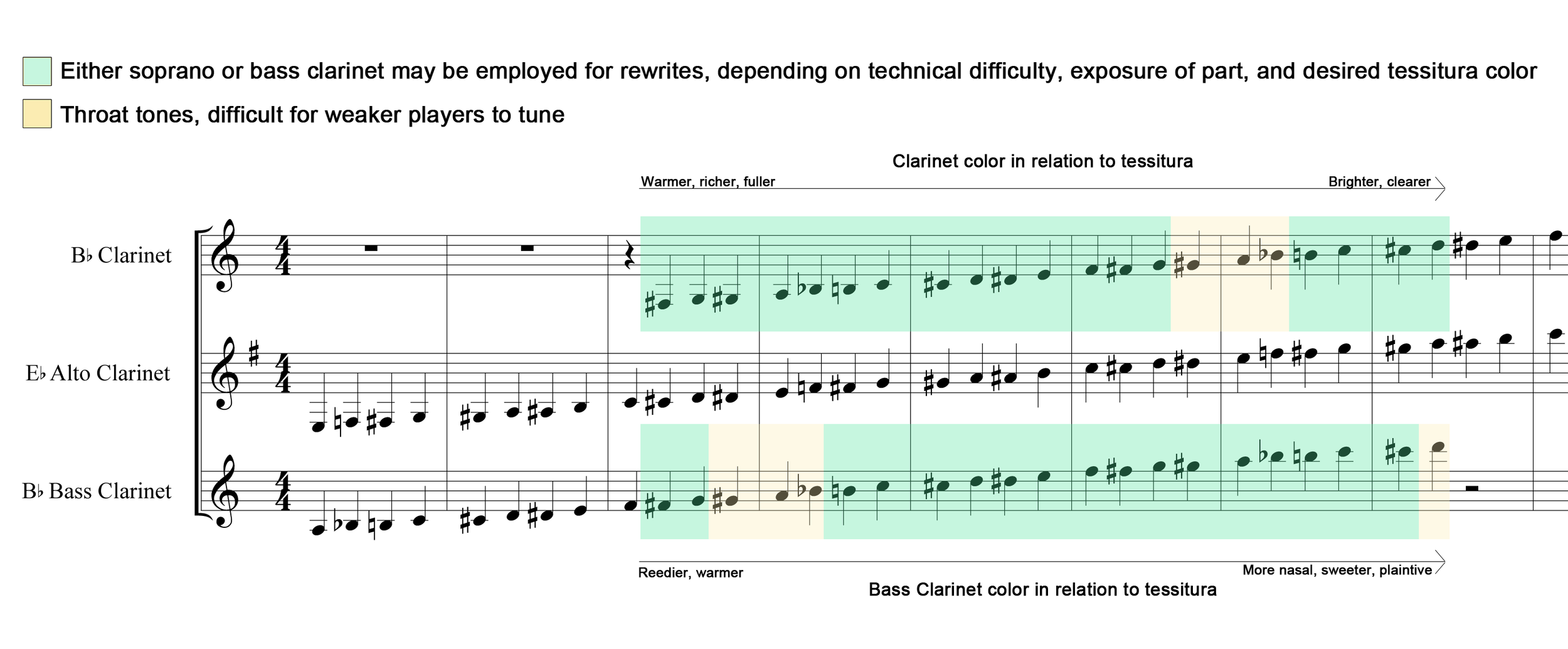
As demonstrated in the chart, the ranges of the bass clarinet and soprano clarinet overlap in multiple areas (green), and both can be used to replace an important alto clarinet part. The part chosen as the target for a rewritten line will depend on the ability of the performer - and therefore the technical difficulty or exposure of the part - and the desired color. The lower range of the soprano clarinet provides a warm, full sound, while the upper clarino registers are clearer and brighter. The bass clarinet is reedier yet warm in the middle register, and becomes increasingly plaintive and sweet in its clarion register. The conductor must evaluate these color changes when choosing which instrument will receive the rewritten alto clarinet part. A mixture of rewrites in the soprano and bass clarinets will often be the result. The orange highlighted areas feature pitches in which particular care should be taken, as these throat tones may prove challenging, especially when weaker players are given the rewritten part. Of course, practical concerns of who is available to perform a rewritten part will need to be considered. For example, if you only have one bass clarinetist, that performer will be busy with their own important lines, and therefore unable to perform many alto clarinet rewrites).
Score Study
Knowing how to look for important alto clarinet parts during your score study can help pinpoint those times when a rewrite is required. This can be challenging, as a large scale work that includes an alto clarinet part often features such a plethora of staves that a unique alto clarinet line can be visually "lost in the shuffle." Also, there are many works and sections of works that simply double the alto clarinet with the bass clarinet, predisposing us to ignore this line. Because of these issues, one of the first steps in your score study should be a thorough inspection of the alto clarinet staff. Look for alto clarinet lines that contain chord tones that are not in any other clarinet part, or lines that double another part in octaves. Finally, look at the areas where the alto clarinet part is exposed while doubling another one or two instrumental parts at the same octave. This is an important color shading that should not be treated as optional.
All of the rewrite examples in this article will be taken from Warren Benson’s The Solitary Dancer and Darius Milhaud’s Suite Française. These works were chosen because they are from composers who have contributed multiple and lasting entries to the wind literature, because they are playable by accomplished high school and undergraduate ensembles, and because this author has put the rewrites into performance practice with his own ensembles. The excerpts given as examples are representative, and by no means the only alto clarinet rewrites necessary in the works discussed.
Unique Alto Clarinet Lines
Warren Benson's The Solitary Dancer features an extremely important alto clarinet voice, creating marvelous open fifths with the bass clarinet, and generating important chord tones not doubled in any other part. The work is truly incomplete without the alto clarinet line. For example, in measures 43-45, a C-minor sonority would be completely absent if not for the alto clarinet’s Eb concert. Designating a third clarinetist to perform this pitch will complete the harmony.
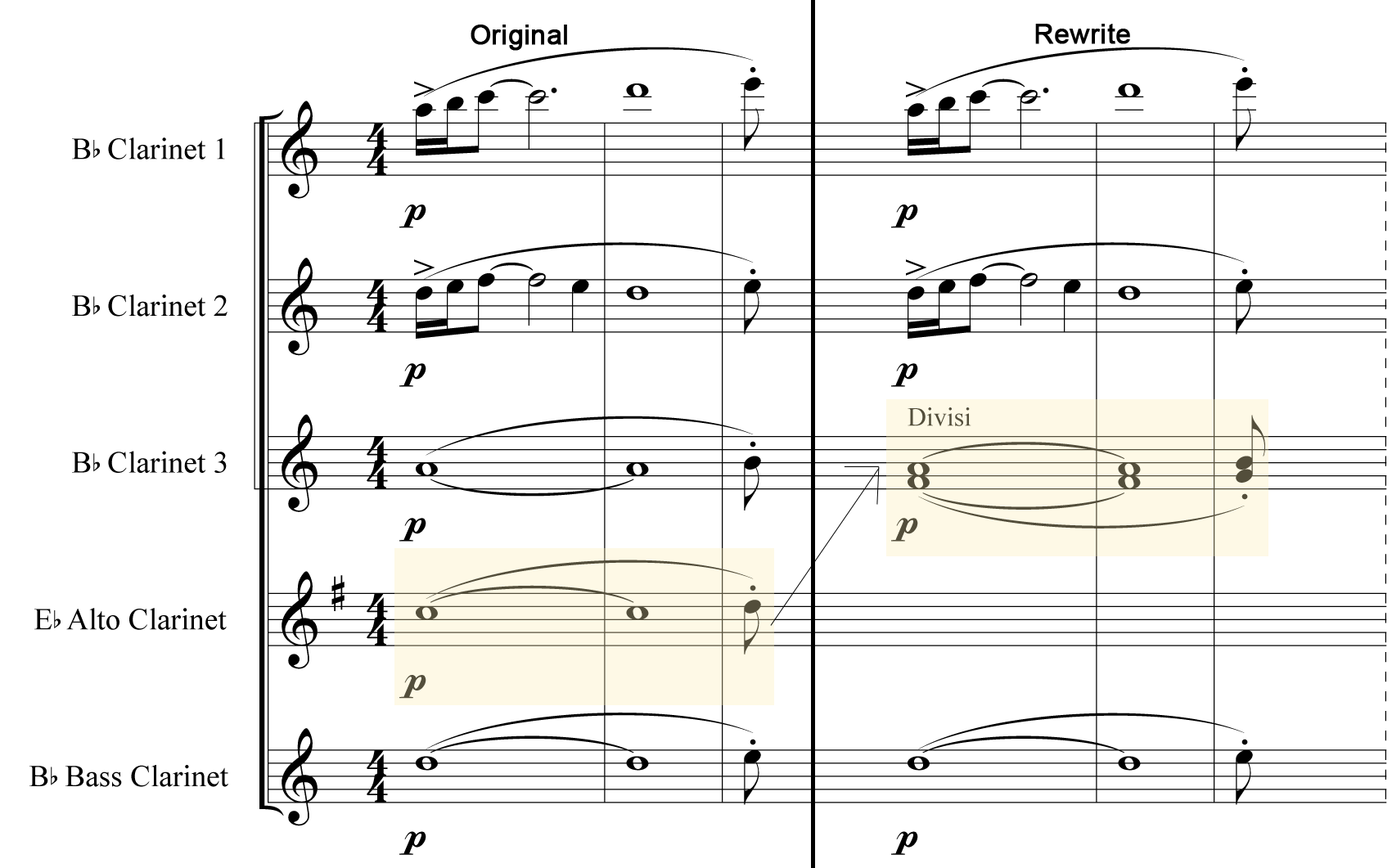
Later, at measure 65, the alto clarinet generates an important open fifth dyad with the bass clarinet part. This open fifth can be rewritten into either a bass clarinet or soprano clarinet part, depending on available performers.

Alto Clarinet Lines that Complete a Clarinet Choir
Even when the alto clarinet's pitch is found elsewhere, rich clarinet choir writing that is missing one voice simply does not achieve the composer's intent. For example, the fourth movement of Darius Milhaud’s Suite Française, “Alsace-Lorraine,” features an exposed clarinet choir choir at measure 55. Though the bassoon 1 and clarinets 2 and 3 take turns covering the pitches in the alto clarinet line, the composer’s clear intent on the page is a clarinet choir; the Eb soprano, all three Bb soprano parts, the alto clarinet, and the bass clarinet are all included in this beautiful, exposed moment. The alto clarinet part is too low for a soprano clarinet to cover, so one bass clarinetist must be assigned to play this rewrite.
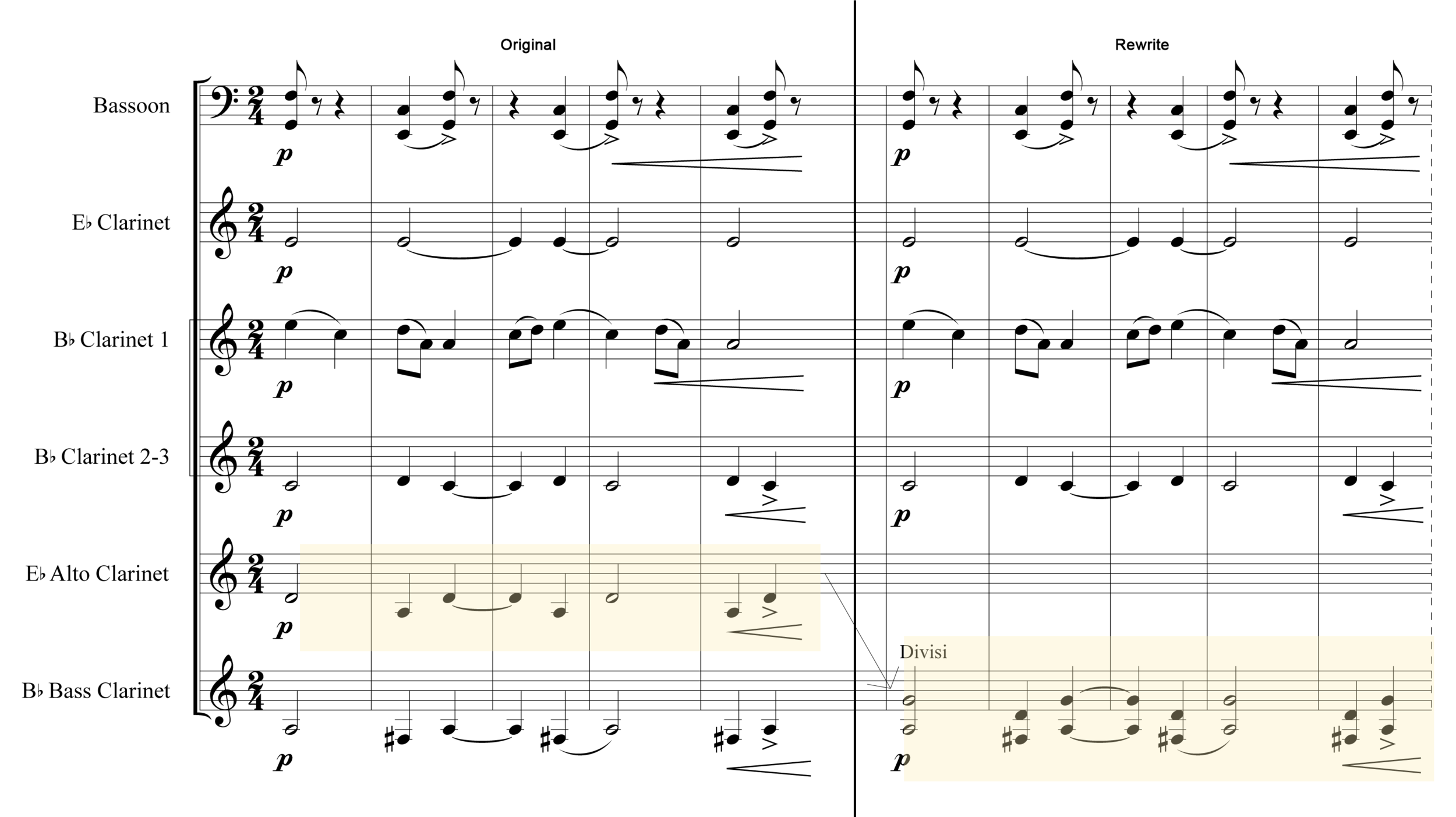
Alto Clarinet Lines that Create Parallel Octaves
Sometimes the alto clarinet part doubles another line in octaves, and this is an extremely important sonic quality to preserve, as parallel octaves are a distinct color and texture all their own. For example, in the third movement of Milhaud’s Suite Française, “Ile de France,” measure 12 features a jaunty descending line of open fourths and fifths in the clarinet choir. The first soprano clarinet and alto clarinet lines are in parallel octaves. While the alto clarinet’s pitches are covered in other instruments and other octaves, omitting this voice leaves a hole in what would be a solid span of a perfect 15th. Placing one or more of the third clarinetists on the alto clarinet line repairs this gap in the sonority.
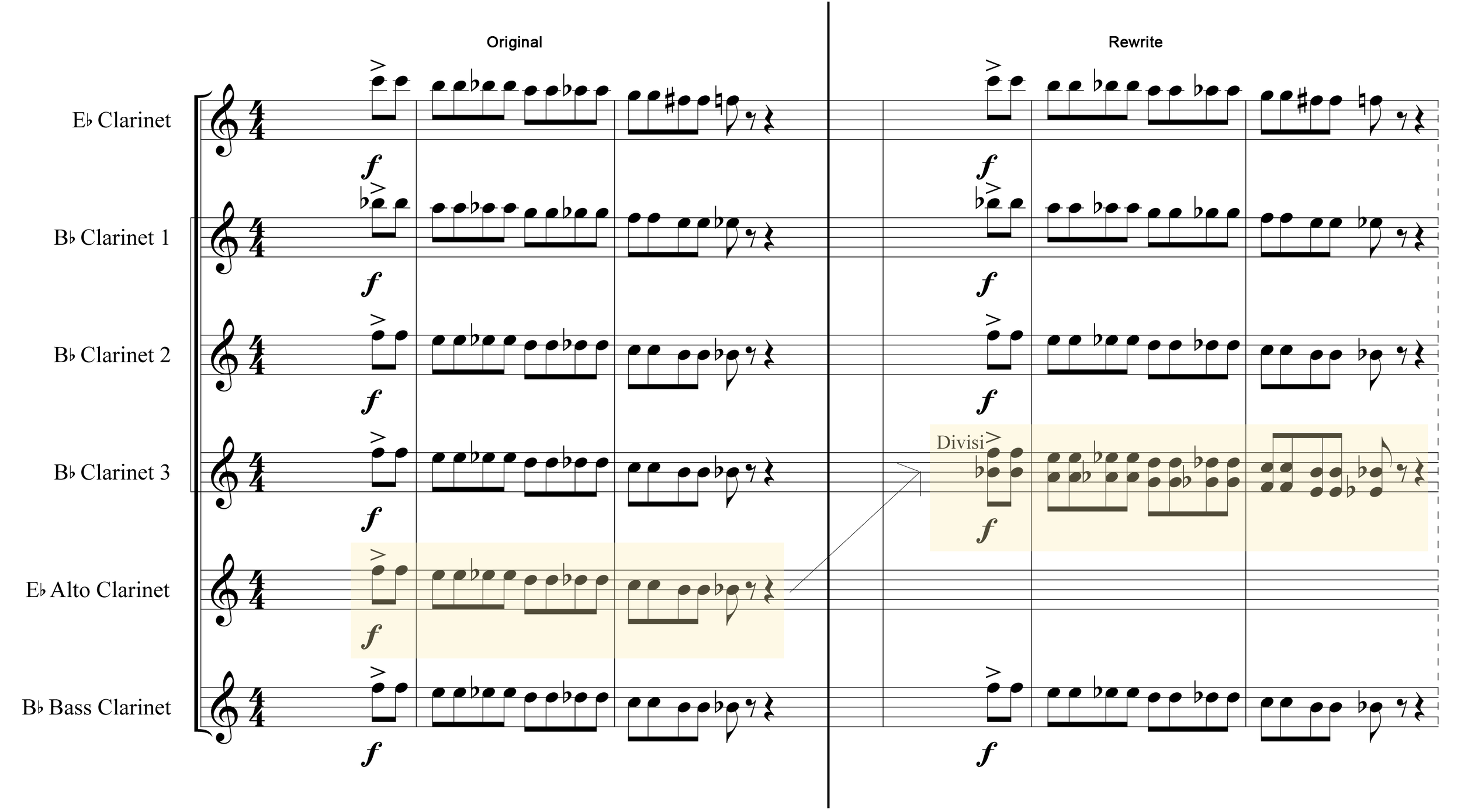
Alto Clarinet Lines that Provide Necessary Color in an Exposed Soli Section
Finally, though you may find the alto clarinet part doubled at the same octave in another voice, the missing clarinet color resulting from ignoring this part can negatively affect the tone quality of your ensemble. This is especially true when the alto clarinet part is only doubling one or two other instruments in an exposed line. For example, Milhaud's Suite Française features gorgeous alto sax lines, especially in the second movement, "Bretagne." These motives are doubled (not cued) in unison by the alto clarinet. While the alto saxes are indeed covering this part, the alto clarinet softens and warms their timbre. Omitting this clarinet voice leads to a brighter, reedier sound that is simply not up to Milhaud's original vision. This necessary rewrite is demonstrated in two areas of the second movement - measures 25 and 36. The same motive is stated by the alto saxophones and the alto clarinet at these two measures, though at different pitch centers. Adding a clarinet voice softens and warms the sound of this line.
At measure 25, the soprano clarinet voice is resting and available, and the register provides an excellent match in timbre to the original alto clarinet part. In addition, the bass clarinet is occupied with a low E concert.
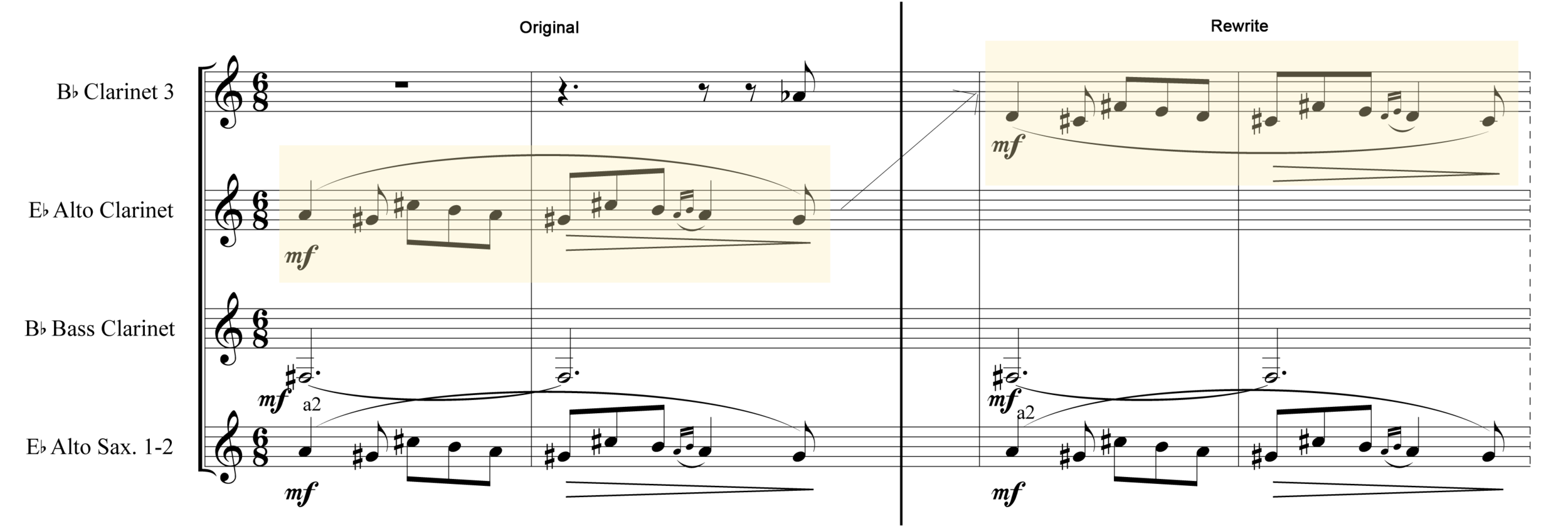
At 36, the motive is stated up a fifth. At this time, the bass clarinet is available to perform a rewrite, and the soprano clarinet would be trapped in a mire of throat tones that would not lead to a desirable sound. Placing the motive into the bass clarinet is more practical, and generates a wonderfully sweet and plaintive sound.
Conclusion
I know this was a lot to read about an instrument we so rarely consider these days. But if you're playing any of that pre-1980 literature, including the two pieces mentioned in this article, I promise it's worth you time to look for the alto clarinet part! While it is highly likely that the alto clarinet will never permanently return to most of our bands, it is important that we not ignore the scoring for this important voice in the earlier wind band literature. As with any other instrument in the ensemble, it was and is an important timbre, and we can still provide this line through other clarinet voices. Taking a moment to scan your score for these important alto clarinet lines, and then rewriting those lines that fall into the categories listed above, will yield a significant and audible improvement in your ensemble’s performance.

